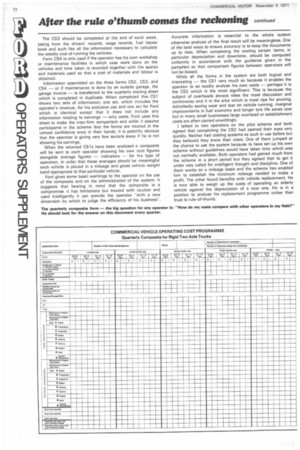After the rule o'thumb comes the reckoning continued
Page 74

If you've noticed an error in this article please click here to report it so we can fix it.
The CS3 should be completed at the end of each week, taking from the drivers records, wage records, fuel issues book and such like all the information necessary to calculate the weekly cost of running the vehicles.
Form CS4 is only used if the operator has his own workshop or maintenance facilities in which case work done on the vehicles and time taken is recorded together with the spares and materials used so that a cost of materials and labour is obtained.
Information assembled on the three forms CS2, CS3, and CS4 — or if maintenance is done by an outside garage, the garage invoice — is transferred to the quarterly costing sheet which is completed in duplicate. When completed this CS1 shows two sets of information; one set, which includes the operator's revenue, for his exclusive use and one set for Ford which is identical except that it does not include any information relating to earnings — only costs. Ford uses this sheet to make the inter-firm comparison and while it assures participants in the scheme that the forms are treated in the utmost confidence once in their hands, it is patently obvious that the operator is giving very few secrets away if he is not showing his earnings.
When the returned CS1s have been analysed a composite will be sent to each operator showing his own cost figures alongside average figures — indicators — for his type of operation. In order that these averages should be meaningful each vehicle is placed in a mileage and gross vehicle weight band appropriate to that particular vehicle.
Ford gives some basic warnings to the operator on the use of the composite and on the administration of the system. It suggests that bearing in mind that the composite is a compromise it has limitations but treated with caution and used intelligently it can provide the operator "with a new dimension by which to judge the efficiency of his business". Accurate information is essential to the whole system otherwise analysis of the final result will be meaningless. One of the best ways to ensure accuracy is to keep the documents up to date. When completing the costing certain items, in particular depreciation and downtime, should be computed uniformly in accordance with the guidance given in the pamphlet so that comparison figures between operators will not be biased.
While all the forms in the system are both logical and interesting — the CS1 very much so because it enables the operator to so readily analyse his own costs — perhaps it is the CS2 which is the most significant. This is because the subject of overheads always rates the most discussion and controversy and it is the area which is most ripe for pruning. Admittedly saving wear and tear on vehicle running, marginal improvements in fuel economy and longer tyre life saves cost but in many small businesses large overhead or establishment costs are often carried unwittingly.
I talked to two operators on the pilot scheme and both agreed that completing the CS2 had opened their eyes very quickly. Neither had costing systems as such in use before but they believed they knew their costs. One of them jumped at the chance to use the system because to have set up his own scheme without guidelines would have taken time which was not normally available. Both operators had gained much from the scheme in a short period but they agreed that to get it under way called for intelligent thought and discipline. One of them works on a mileage basis and the scheme has enabled him to establish the minimum mileage needed to make a profit. The other found benefits with vehicle replacement. He is now able to weigh up the costs of operating an elderly vehicle against the depreciation of a new one. He is in a position to analyse his replacement programme rather than trust to rule-of-thumb.




































































































































































